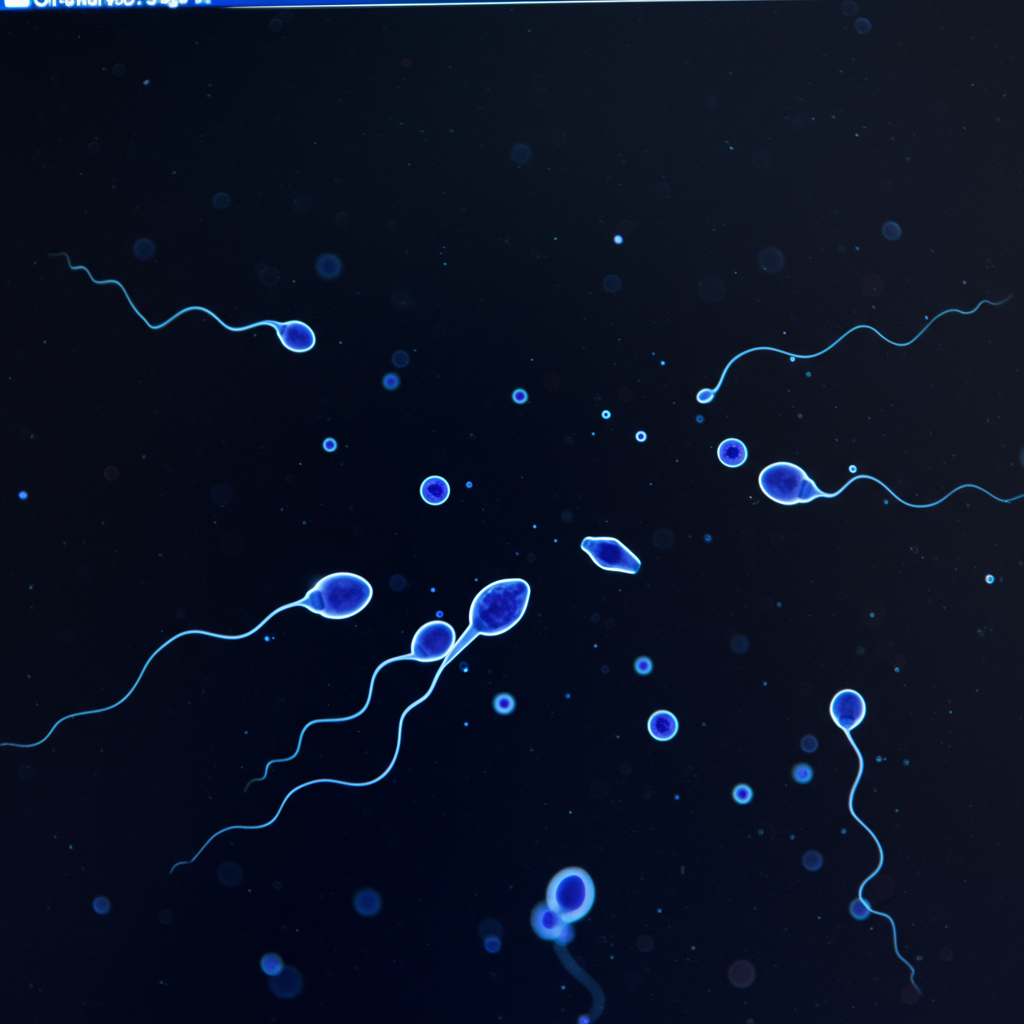For couples facing the profound challenge of infertility, the journey can be long and emotionally taxing. After nearly two decades of trying to conceive and multiple unsuccessful attempts at in vitro fertilization (IVF), one couple has finally found hope, thanks to a cutting-edge application of artificial intelligence.
AI is rapidly transforming various aspects of healthcare, and its impact on fertility care is becoming increasingly significant. At the Columbia University Fertility Center, experts are leveraging AI to tackle one of the most difficult aspects of male infertility: finding rare, hidden sperm in men diagnosed with azoospermia.
Overcoming the Obstacle of Azoospermia
Azoospermia is a medical condition characterized by the absence of measurable sperm in a man’s semen. While a typical semen sample contains millions of sperm cells, men with azoospermia have counts so low that traditional microscopic searches often fail to locate any viable sperm, even after extensive effort. This diagnosis can be a heartbreaking and unexpected blow, as many men with the condition feel otherwise healthy and show no outward signs of impaired sexual function. The challenge lies hidden at the microscopic level, where normal semen appears empty of the hundreds of millions of swimming sperm expected.
Traditionally, treatment options for azoospermia have been limited. One common approach involves invasive surgery to retrieve sperm directly from the testes. This procedure, where a portion of the testes is removed and examined, is painful, carries risks of permanent scarring and damage, and can only be attempted a limited number of times. Hormone therapy is another option but is only effective if the azoospermia is caused by a hormonal imbalance. For many couples facing this diagnosis with limited or unsuccessful treatment options, using donor sperm has been the primary path to parenthood.
Introducing the AI-Powered STAR Method
Recognizing the limitations of existing methods, a team led by Dr. Zev Williams, director of the Columbia University Fertility Center, dedicated five years to developing a novel approach. their innovation, called the STAR method (Sperm Tracking and Recovery), utilizes artificial intelligence to revolutionize the search for sperm in even the most challenging samples.
The STAR system connects to a microscope via a high-speed camera and advanced imaging technology. A semen sample is placed on a specially designed chip, and the AI system gets to work. In under an hour, it scans the sample, capturing millions of images – a volume of visual data far exceeding what a human technician could process in the same timeframe. Trained to identify the subtle characteristics of sperm cells, the AI can pinpoint potential candidates with remarkable speed and precision.
Once identified, the system instantly isolates the potential sperm cell within a minuscule droplet. This allows embryologists to quickly locate and recover cells that might have been completely missed during hours of manual searching under a microscope. Dr. Williams likens the process to finding a few needles scattered across thousands of haystacks, but doing it gently and rapidly without harmful lasers or stains that could damage the sperm.
The power of the system was starkly demonstrated when technicians spent two days manually searching a sample and found nothing. The AI-based STAR System then analyzed the same sample in just one hour and identified 44 sperm cells. This dramatic difference highlights the AI’s potential as a game-changer in cases previously considered hopeless.
A Couple’s Journey to Parenthood
For the couple who had spent 18 years trying to have a baby, the STAR method offered a glimmer of hope after countless disappointments worldwide. Despite keeping their expectations low, they provided a semen sample to the Columbia team. Using the AI system, researchers meticulously analyzed the sample. Astonishingly, three hidden sperm cells were located and successfully recovered – numbers far from the hundreds of millions in a typical sample, but enough for a chance.
These three viable sperm were then used to fertilize the wife’s eggs through IVF. The process resulted in a successful pregnancy, marking the first achieved through the STAR method. For the wife, the news was almost unbelievable after so many years of setbacks. She described taking two days to accept the reality of her pregnancy, stating she still finds it hard to believe until she sees scans. This emotional reaction underscores the depth of the struggle faced by couples dealing with long-term infertility.
Broader Applications of AI in Fertility
The STAR method represents a significant step forward for male infertility, but AI is impacting many other areas of fertility care. According to experts like Dr. Sevann Helo, a urologist specializing in male infertility, AI excels in pattern recognition, making it ideally suited for analyzing images like those of sperm, eggs, or embryos. It learns what a healthy cell or embryo looks like and uses this learning to identify them.
Dr. Aimee Eyvazzadeh, a reproductive endocrinologist, highlights several other ways AI is enhancing fertility treatments. Algorithms such as Stork-A are used to analyze early-stage embryos and predict their viability with surprising accuracy. Another tool, CHLOE, helps assess the quality of a woman’s eggs before they are frozen for later use. AI is also being applied to personalize IVF medication protocols, reducing guesswork and increasing efficiency. Furthermore, AI can assist in selecting the healthiest sperm in standard samples and even predict overall IVF success rates with greater precision by analyzing vast datasets.
These AI applications share a common goal: improving decision-making, boosting patient confidence, and creating a more compassionate experience throughout the complex fertility treatment process. AI isn’t replacing human expertise; it’s amplifying it, helping clinicians see and evaluate details that are difficult or impossible for the human eye alone.
Cost, Accessibility, and Future Outlook
The development of the STAR method was a collaborative effort driven by the desire to help couples who previously had no viable options for biological children. Currently, the method is available exclusively at the Columbia University Fertility Center. However, the research team intends to publish their findings, hoping to share the technology and make it accessible to other fertility centers globally. Locating, isolating, and freezing sperm using the STAR method for a patient is estimated to cost a little under $3,000 total.
Despite the promising initial results, the application of AI in reproductive medicine is not without its challenges and requires careful validation. Dr. Gianpiero Palermo, an expert in embryology, notes that while AI offers potential for unbiased evaluation of embryos, current models can be inconsistent and need further validation. He emphasizes that AI tools like STAR require human embryologists to perform the crucial steps of sperm retrieval and injection into the egg for IVF. While AI might speed up the search or find one or two more sperm, it doesn’t guarantee success, as some men with azoospermia truly may have no viable sperm, regardless of the screening method used.
However, the ability to find even a handful of viable sperm where none were thought to exist offers profound hope. Infertility is an ancient challenge woven into human history. The fact that cutting-edge technologies like AI are now being used to address this age-old problem is truly remarkable. AI is not creating sperm; it is making the invisible visible, potentially offering a path to parenthood for couples who had reached the end of traditional treatment options.
Frequently Asked Questions
What is the STAR method and how does AI help find sperm?
The STAR method, or Sperm Tracking and Recovery, is a novel technique developed at Columbia University Fertility Center. It uses an AI system connected to a high-speed microscope and camera to scan semen samples, particularly from men with azoospermia. The AI is trained to rapidly identify and locate individual sperm cells, even when counts are extremely low. It then isolates these potential sperm into tiny droplets, allowing embryologists to retrieve them for use in IVF, a process much faster and potentially more effective than manual searching.
Where is the STAR method currently available for male infertility treatment?
As of the information available, the STAR method for AI-assisted sperm retrieval is currently offered exclusively at the Columbia University Fertility Center. The research team plans to publish their work to facilitate the adoption of the technology by other fertility centers in the future, increasing its accessibility to more couples.
Should men with azoospermia consider AI-assisted sperm retrieval like the STAR method?
Men diagnosed with azoospermia who have not found success with traditional treatments, such as surgical sperm retrieval or hormone therapy, may consider discussing AI-assisted methods like STAR with their fertility specialist. While still a novel technique requiring further validation, it offers a potential option to find viable sperm in cases where manual searches fail, providing a chance for biological parenthood that was previously unavailable. It’s crucial to consult with fertility experts to understand if this method is appropriate for their specific situation.
The application of AI in fertility treatment, particularly for challenging conditions like azoospermia, marks an exciting new era in assisted reproductive technology. By enhancing the ability to find viable sperm, AI offers renewed hope for many couples on their difficult journey to build a family. While continued research and validation are essential, the potential impact of these technologies is immense, pushing the boundaries of what is possible in fertility care.



